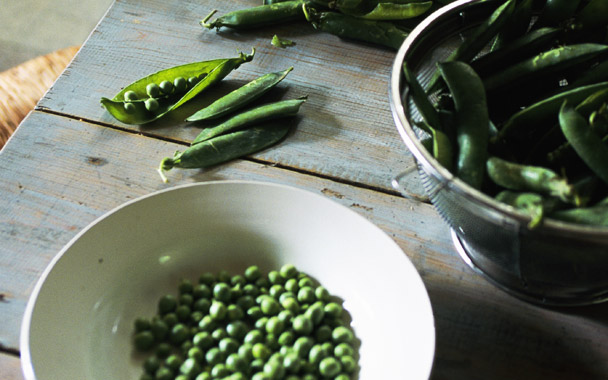While in other parts of our lives we are pretty similar, in the garden Stephen and I can sometimes become the odd couple—me being Oscar Madison to his Felix Unger. He’s a professional gardener, after all, and he likes things to be, well, perfect—no bug left standing, no weed left unyanked, no compost left unturned. I’m not exactly playing poker in the potato patch and toking on a cigar, but I have been known to carelessly stomp on a healthy bunch of thyme, water the leaves of our plants with abandon instead of targeting their bases, or ignore a bunch of clover that’s threatening to take over the Brussels sprouts. “They’ll be fine,” I say, pointing, by example, to a neighbor’s plot where the weeds have grown as high as the seemingly thriving tomato plants.
In any garden, as in any friendship, you have to learn to appreciate the other person’s style and maybe tone yours down for the sake of harmony. As the season has progressed, I’ve made an effort to be more hands-on and Stephen has become more easygoing. And our individual quirks are all but forgotten when we see that the peas—which have been crawling up the trellis and ripening for a couple of weeks—are ready to pick, and that there’s a healthy crop of sweet Walla Walla onions, mâche, radishes, and more mesclun greens. We gush like parents at their kid’s first piano recital. It’s time to take our routine to the kitchen.
People can get a little mushy about peas, says Gourmet writer Francis Lam, meaning mushy in the overly romantic sense, not in the way the English have been known to cook their peas. But even we curmudgeons find it hard not to be smitten with them, when they show up all sweet and eager to please. We’d taken some risks with this crop, having chosen seeds that were not treated with inoculant against root rot (just before the spring rain came and then never seemed to leave) and then planting the seeds as close together as peas in a pod would be. That they’d made it was cause for celebration.
Shelling peas across the table from Stephen made me feel less like Oscar Madison and more like a character from Fried Green Tomatoes. All we needed were glasses of bourbon. But instead of cooking a southern dish like smashed potatoes and peas or Edna Lewis’s classic peas in cream, we had an Italian-inspired pasta in mind, a simple dish that Stephen’s grandfather Chiarmonte used to make for the family way back when, of sautéed sweet onions, garlic, basil, oregano, cappicola, and fresh peas, mixed with short pasta such as ditalini and a good dose of ricotta cheese. The peas, picked about two hours before we planned to eat them, were at peak sweetness and smooth texture, their flavor playing off the creaminess of the ricotta, the mellow Walla Wallas, and the saltiness of the meat. It didn’t shout “Peas!” as a soup might (we don’t have enough peas for a big pot of soup, anyway). But they seem content and delicious being a part of an ensemble.
The mâche could have stood alone, dressed with a little olive oil, and been perfect, but throwing in our other greens and tangy radishes felt more like a family reunion.
Which was the flavor this entire meal had—the pride at having coaxed and nurtured something into being, the memory of a beloved grandfather, and the pleasure of having a friend who, regardless of how contrary we can sometimes be, has made me a part of his clan.

